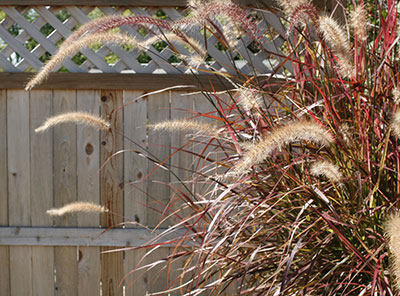Ornamental Grasses
If you’re looking for something different in your landscape, ornamental grasses can’t be beat for their variety and versatility.

The term “ornamental grass” refers to true grasses, as well as other plants that have a grass-like appearance.
Ornamental grasses offer something for everyone, whether it’s as groundcover, a border, or accent plants.
Ornamental grasses are either clump-forming or creeping. Clump-forming grasses are also called bunch grasses. They grow in compact tufts, with their bases gradually increasing in size. Creeping grasses are also called running and spreading grasses.
Ornamental grasses can be annual or perennial, and come in a wide range of sizes, from a few inches to many feet in height. They come in different colors and textures, and many have attractive flowers.
Many gardeners use ornamental grasses for their easy maintenance, but new varieties are more than just workhorses—they make a showstopping visual statement.
Many cultivars of fountain grass, including ‘Princess Caroline’, have wide, deep burgundy leaves that make a bold statement in the garden. If bright colors are your thing, try a cultivar like ‘Fireworks’ with pink and magenta variegated leaves. Several types of ornamental millet provide both striking foliage and dramatic flower spikes.
Other grasses offer garden drama when planted en masse. Muhly grass blooms create a dramatic cloud of pink each fall that you can’t miss.
Pruning Ornamental Grasses
Ornamental grasses often have attractive winter characteristics that should be preserved through the colder months. But the weather can leave them looking a bit ragged. Since many grasses keep their showy flower stalks through the winter, wait to prune until late winter or early spring, just prior to new shoot growth.
In North and Central Florida, prune ornamental grasses in February and March. In South Florida, you may wish to cut back or trim ornamental grasses in January or February.
For deciduous grasses like some Miscanthus, the old foliage may be completely removed with a chainsaw or hedge shears. For evergreen grasses like Fakahatchee grass, the ragged, dead leaves can be removed by combing the grass with a pitchfork.
Also on Gardening Solutions
- Add a Thrilling Porch Planter for Fall
- Bamboo Muhly
- Fakahatchee Grass
- Flax Lily
- Lemongrass
- Lovegrass
- Maiden Grass
- Mondo Grass
- Muhly Grass
- Native Grasses
- Purple Fountain Grass
- River Oats
